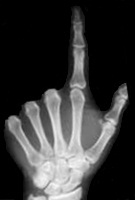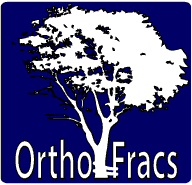Journal Club
June 2010
Limb Geometry After Elastic Stable Nailing for Pediatric Femoral Fractures
Khaled Hamed Salem and Peter Keppler
Department of Orthopaedic Surgery, Cairo University, 11562 Cairo, Egypt
JBJS Am 2010;92:1409-1417
Reviewed by
Dr Emily Kong MBBS | Accredited Orthopaedic Registrar
Introduction
- Non-operative Mx of femoral shaft fracture's relies on capacity to remodel
- Previous lack of suitable implants to stabilise growing bones
- Indications for operative Mx
- Irreducible fracture
- Open fracture
- Assoc. neurovasc injuries
- Polytrauma inc. head injuries
- Intramedullary fixation with use of Elastic Stable Intramedullary Nailing (ESIN)
- Safe - Minimally invasive: closed reduction
- Cost-effective: shorter hospital stay, no casting, no prolonged bed rest
- Potential for earlier weight bearing
- Cx post-op malalignment or LLD
- Aims
- To determine the rate of
- Early femoral and whole-limb malalignment
- Limb length discrepancy
- The influence of the fracture pattern on the above complications
- To determine the rate of
Methodology
- Prospective study August 1991 to August 2002
- 68 pts with unilateral femoral shaft fracture
- Exclusion criteria
- Other LL injuries
- Neurological deficits
- Written consent to participate not obtained
- Patients
- 46 Males, 22 Females
- Mean age 5.6yrs: range 1.9 to 10.5yrs
- Mean body weight 21kg: range 10 to 45kg
- Mean duration of follow-up 6 mths: range 4 to 7 mths
- Classified according to
- AO/ASIF
- Type A 57 pts (84%)
- Type B 11 pts (16%)
- Location of shaft fracture
- 48pts middle 1/3 (71%)
- 13pts proximal 1/3 (19%)
- 7pts distal 1/3 (10%)
- AO/ASIF
- Operative technique
- closed reduction with percutaneous retrograde insertion through distal femoral metaphysis
- No open reduction, bone grafting or additional stabilization
- Results
- All fracture's united uneventfully
- Implants removed at 3 to 7mths
- Measurement
- Limb length and rotation assessed at 4 to 7mths to determine axial and torsional alignment
- Measured before significant remodeling occurred
- Implants removed prior to measuring
- 1st 21pts measured using CT scans
- Remainder of pts measured with U/S scans
- CT scan performed scout views through
- Centre of femoral head
- Greater trochanter
- Femoral condyles 2cm proximal to knee jt line
- Tibial condyles distal to articular surface
- Distal tibia proximal to the plafond
- U/S:
- Measurement of LL, femoral torsion, mechanical axis deviation
- 2D U/S coupled with 3D navigation system
- Axial alignment
- AP and lateral XR taken just before nail removal
- Anatomical axis through femur and tibia measured
- Limb length and rotation assessed at 4 to 7mths to determine axial and torsional alignment
- Statistical Methods
- Wilcoxon test for paired data (injured Vs uninjured)
- Leg lengths
- Femoral torsion
- Axial deviation
- Kruskal-Wallis test to compare multiple unrelated groups
- fracture patterns
- Wilcoxon test for paired data (injured Vs uninjured)
Results
- Femoral Length
- No significant difference in femoral length between injured and uninjured limbs (p=0.5)
- Mean length 316.3mm Vs 315.7mm
- 41 lengthened, 27 shortened
- Spiral fracture mean shortening 0.9mm
- Transverse fracture mean lengthening 2.15mm
- Wedge fracture 0.7mm
- oblique fracture 1.5mm mean lengthening
- Limb lenght
- Measurement of entire limb length (hip to ankle)
- Mean LLD 2 +/- 6.4mm
- 43 pts (63%) lengthened (max 14mm)
- 25 pts shortened (max 13mm)
- 11 pts (16%) lengthened >10mm
- Angulation of fracture
- Varus and procurvatum in 24 pts
- 30 pts angulation 10° to 15°
- 1 pt 15°valgus and 6° recurvatum due to technical error
- Nails of different diameter inserted
- Mechanical axis
- Mean similar on both sides measured with U/S
- 180.7° normal side, 180.8° injured side
- Maximum 7° valgus, 4° varus
- 1 pt mechanical axis deviation of entire limb of 5°
- Mean similar on both sides measured with U/S
- Femoral torsion
- Median value of internal torsion signif different (p<0.001)
- Injured side -15.5°
- Normal side -28°
- Maximum relative internal torsion -25°
- Maximum relative external torsion 51°
- 32 pts (47%) side to side torsional angle difference ≥15°
- Median value of internal torsion signif different (p<0.001)
- All fracture patterns showed relative tendency for external malrotation
- Transverse 9.5°
- Oblique 10°
- Spiral 15°
- Wedge 20°
- Whole limb torsion was measured and compared bilaterally
Discussion
- Advantages
- Better reduction
- Axial stability
- Shorter hospitalisation with early rehabilitation
- Low complication rate
- Disadvantages
- Closed reduction may not always lead to anatomical reduction
- Low torsional stability of the nail leads to higher rates of
- Malrotation
- Axial deviation
- LLD
Pros of Study
- Measures affects of ESIM before remodeling takes place
- Gives exact measurements with comparison to the uninjured side
Cons of Study
- Short follow up period
- No comparison to non-operative Rx outcomes
- No functional outcome
- ?Remodeling corrects initial post op deformity
- Measurements taken after implant removal
- ?Malrotation due to poor torsional stability of nail or operative technique
Journal Club Discussion
- Consultant Comments
- Monitor unstable fracture's carefully
- Consider additional immobilization (ie: hip spica) if concerns about stability of fixation
- Aim for nail diameter to be 1/3 of medullary canal
- Avoid implanting nails of different diameter
- General recommendation to leave nails in for longer than the article suggests (ie: 6 to 12 months)
- If nails left too long, can become irritating at insertion point and limit flexion of the knee
Take home message
- Elastic Nailing for Paediatric Femoral Fractures offers significant advantages.
- Better reduction
- Axial stability
- Shorter hospitalisation with early rehabilitation
- Low complication rate
- However
- Closed reduction may not always lead to anatomical reduction
- Low torsional stability of the nail leads to higher rates of
- Malrotation
- Axial deviation
- LLD
- Tendency for Femoral External Malrotation
- If concerned regarding fracture stability - augment with hip spica
Webpage Last Modified:
30 June, 2010



